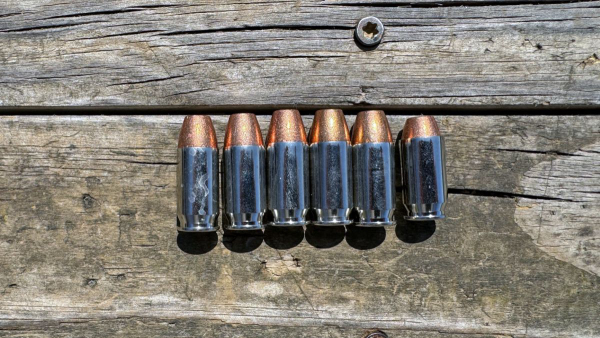In working on a pistol evaluation recently, I fired a range of makes, bullet weights, etc. through a test gun. When taking factory ammo from a box, I noticed something odd – one cartridge was shorter than the others … a lot shorter.
Factory ammo.

Which doesn’t belong and why?
What’s the problem with a deep-seated round? Aside from potential feeding issues, there’s the possibility of an over-pressure round. Best to discard it.
It happens. I’ve seen bullets seated backwards, primers seated upside down – or, in one memorable case decades ago, the primer was missing. I was warned about a brand of ammo in the 1970s after a revolver tied up when firing that factory ammo. The post-mortem, I was told, showed that the bullet was properly seated, they found a nominal amount of powder, but they kept busting decapping pins trying to get the profoundly bulged primer out of the case.
The case had no flash hole for the primer to fire through.
They say.
I’ve seen the other stuff, including a projectile seated out of alignment with the cartridge case. The case was mangled as the bullet was seated. It was surprising to find this as the cartridge didn’t easily come out of the plastic tray like the others.
It was jammed in there.
Those are memorable. The thousands of rounds I’ve fired and the likely millions of rounds I’ve witnessed being shot – no problems. No one remembers them.
The point is, before you load up – particularly if it’s duty/carry ammo – visually inspect each round. A smart move is to remove the barrel from the pistol the ammo’s meant for (or the revolver’s cylinder) and drop each round into the chamber.
This checks easy fit. Upend the barrel/cylinder; does the round fall out? That’s also a good sign.
If the rounds are loaded in those factory boxes with individual round trays, take that opportunity to check the case heads for dings, deformation – and check the primers to ensure they’re seated in the proper orientation and seated just below flush.
A friend providing armorer service at his agency had people bring their guns in for annual maintenance and inspection. They had to bring the ammo too, which he would set projectile up on a sheet of cardboard.
He’d done one gun and as he picked up a round of ammo, he saw he could read the headstamp on the cardboard – where the image was deposited by the oily film on the case head. Yep – the deputy had lubricated his ammunition, including the case heads, with penetrating oil.
Killed them dead as Martha Washington. He’d have had a hell of a surprise if he’d needed to shoot for real.
It’s not the equipment, the ammo, the gear, it’s what you do with it and how you prepare it for that day.
Don’t rely on factory quality control. Do your own examination. Make sure it looks right and feels right.
I knew one cop who was a reloader. When he received new duty ammo annually, he’d weigh it on his reloader’s scale looking for a broad variation – up or down.
He’d run his index finger over the case head of each round – having once in his career received a round with a high primer.
You’d inspect your parachute before a jump. You’d inspect your tank, regulator, hose(s), etc. before a dive.
Inspect your ammo. That pays dividends.
— Rich Grassi